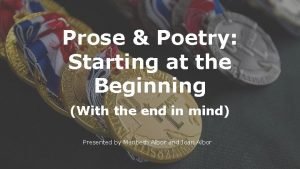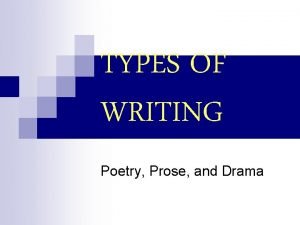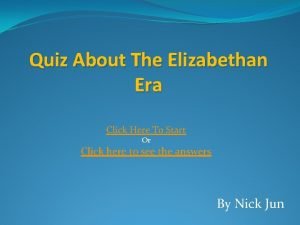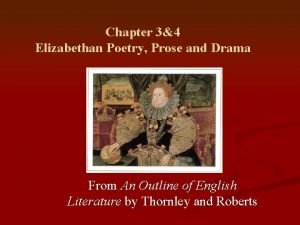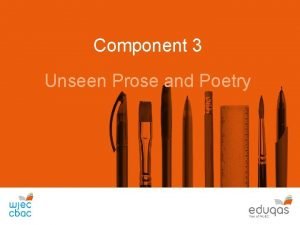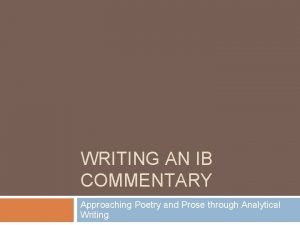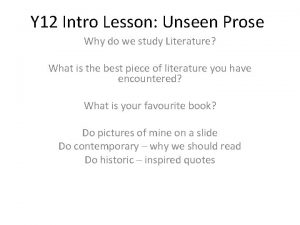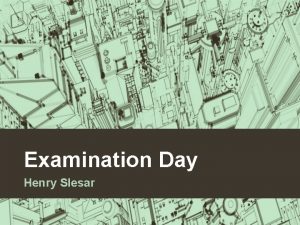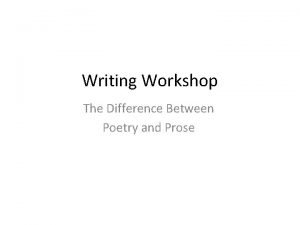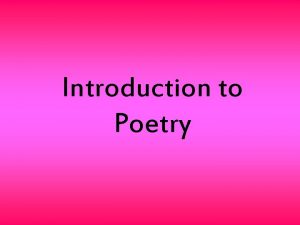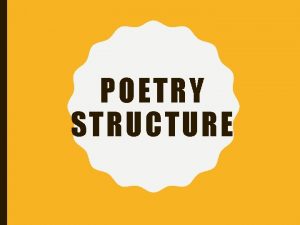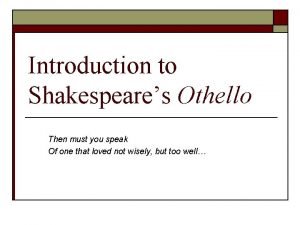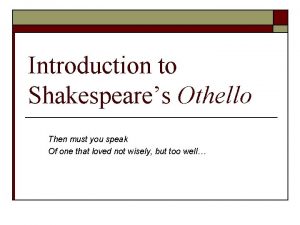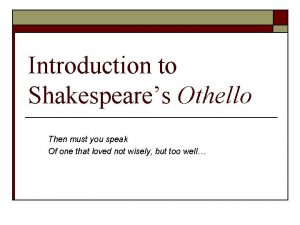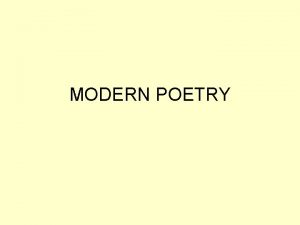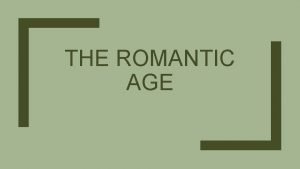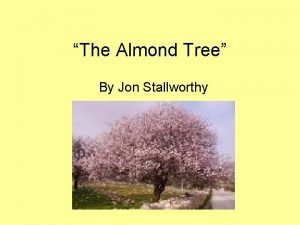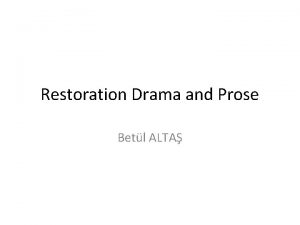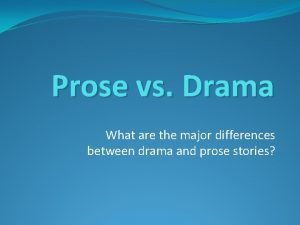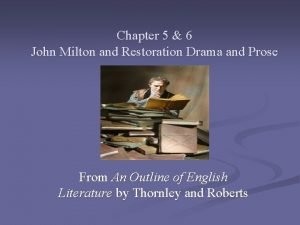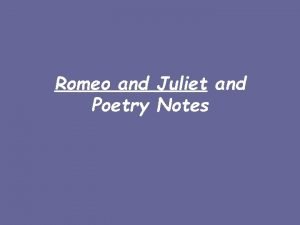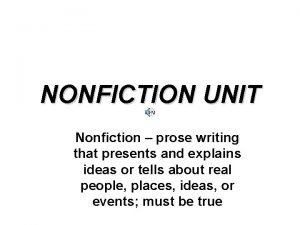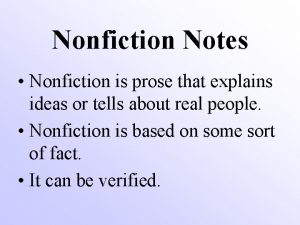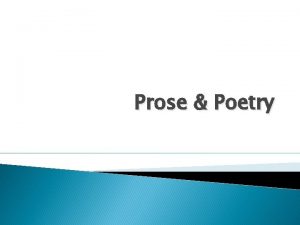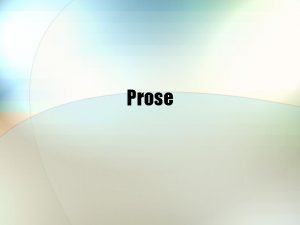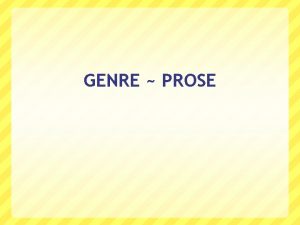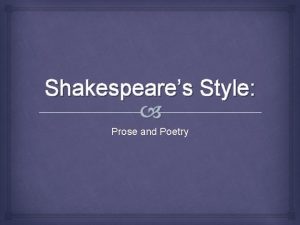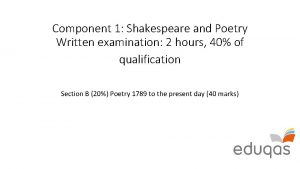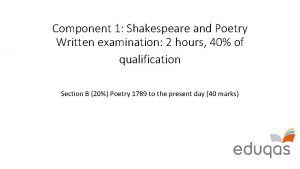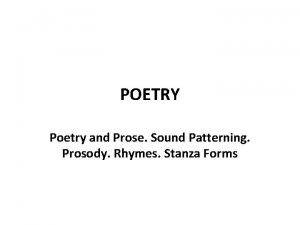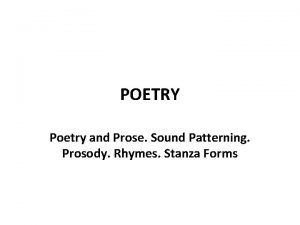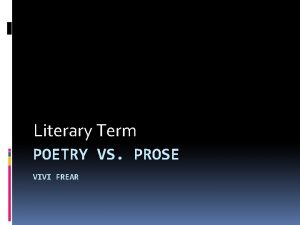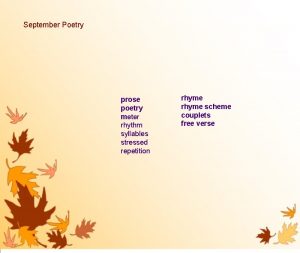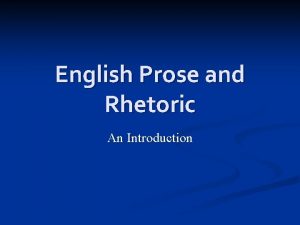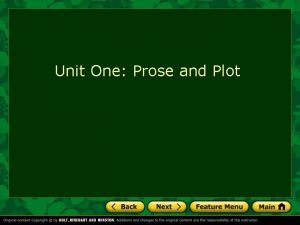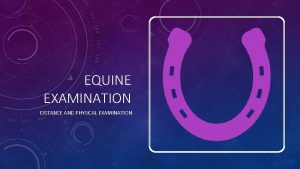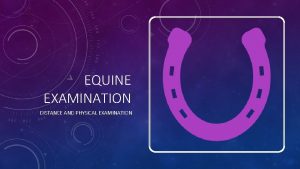COMPONENT 1 POETRY AND PROSE WRITTEN EXAMINATION 2





























- Slides: 29

COMPONENT 1 – POETRY AND PROSE WRITTEN EXAMINATION – 2 HOURS (30% OF MARK) • SECTION A: (POETRY) (OPEN BOOK) One question from a choice of two based on Anthology plus an unseen text. • SECTION B: (PROSE) (OPEN BOOK) • One question from a choice of two, presented in two parts, based on the reading of ‘Atonement’. COMPONENT 2 – DRAMA WRITTEN EXAMINATION – 2 HOURS (30% OF MARK) • SECTION A: (Shakespeare) (CLOSED BOOK) One compulsory extract task and one essay question from a choice of two. • SECTION B: POST-1900 DRAMA (CLOSED BOOK) One question from a choice of two based on ‘Who’s Afraid of Virginia Woolf? ’ COMPONENT 3 – NON-LITERARY TEXTS WRITTEN EXAMINATION (2 HOURS) (20% OF MARK) • SECTION A: Comparative analysis of spoken non-literary texts Comparative analysis of three unseen, spoken language non-literary texts • SECTION B: One two-part question based on ‘Once in a House on Fire’. (CLOSED BOOK) COMPONENT 4 – CRITICAL AND CREATIVE GENRE STUDY (20% OF MARK) NON EXAM ASSESSMENT • SECTION A: GENRE STUDY and SECTION B: CREATIVE WRITING (2 PIECES)

The year ahead with me (only). . LP 1 – ATONEMENT PLUS 1 WEEK COURSEWORK LP 2 – ATONEMENT PLUS 1 WEEK COURSEWORK LP 3 – WHO’S AFRAID OF VIRGINIA WOOLF? PLUS 2 WEEKS COURSEWORK COMPLETION LP 4 – ONCE IN A HOUSE ON FIRE LP 5 – REVISION OF ALL TEXTS

Lesson 1 Learning Objective: To INVESTIGATE Mc. Ewan’s opening to the novel. Learning Outcome: To EVALUATE how Mc. Ewan uses linguistic techniques to shape meaning. Literacy Objective: All sentences begin with capital letters. All proper nouns begin with capital letters. The pronoun I is always a capital letter.

Atonement A LEVEL ENGLISH LANGUAGE AND LITERATURE What is ‘atonement’? • Atonement is a concept. It refers to making up for one’s sins. It’s more than saying sorry. It’s making amends. It also involves coming to terms with the fact that you’ve changed and accepting what’s happened ‘at-one-ment’.

Atonement Epigraph • An epigraph is a quote/poem at the beginning of a novel intended to introduce its theme. • Mc. Ewan used an epigraph from Jane Austen’s novel ‘Northanger Abbey’. • ‘Northanger Abbey’ is about a woman called Catherine Morland who is an avid reader of Gothic novels and has trouble observing boundaries between reality and fiction. She decides her boyfriend’s father has imprisoned or murdered his wife. This is without foundation. • In this extract, she is reprimanded by her boyfriend for allowing her imagination to run away with her. • Why has Ian Mc. Ewan used this extract as an epigraph?

Engage David Lodge: The Art of Fiction, 1992 There are many ways of beginning a novel. A novel may begin with: • a set-piece description of a landscape or townscape that is to be the primary setting of the story; • A novel may begin in the middle of a conversation; • It may begin with an arresting self-introduction by the narrator; • A novelist may begin with a philosophical reflection – or pitch a character into extreme jeopardy with the very first sentence; • Many novels begin with a frame story which explains how the main story was discovered or describes it being told to a fictional audience.

The play – for which Briony had designed the posters, programs and tickets, constructed the sales booth out of a folding screen tipped on its side, and lined the collection box in red crêpe paper – was written by her in a two-day tempest of composition, causing her to miss a breakfast and a lunch. When the preparations were complete, she had nothing to do but contemplate her finished draft and wait for the appearance of her cousins from the distant north. There would be time for only one day of rehearsal before her brother arrived. At some moments chilling, at others desperately sad, the play told a tale of the heart whose message, conveyed in a rhyming prologue, was that love which did not build a foundation on good sense was doomed. The reckless passion of the heroine, Arabella, for a wicked foreign count is punished by ill fortune when she contracts cholera during an impetuous dash toward a seaside town with her intended. Deserted by him and nearly everybody else, bed-bound in a garret, she discovers in herself a sense of humour. Fortune presents her a second chance in the form of an impoverished doctor—in fact, a prince in disguise who has elected to work among the needy. Healed by him, Arabella chooses judiciously this time, and is rewarded by reconciliation with her family and a wedding with the medical prince on “a windy sunlit day in spring. ”

Which of these apply to the opening of the novel? a) The plunge – in which the reader is thrust straight into the middle of things – almost as though they knew the story already. b) The shocker – in which the attention of the reader is grabbed by a shocking, astonishing or outrageous event, idea or statement. c) The intriguing narrator – in which the reader is engaged through their interest in the person telling the story. d) The epigram – a concise, often witty, statement capturing an idea that the novel will explore or develop. e) The promise – in which the reader is told what they can look forward to (for example, that the story to follow will be the saddest, most horrific, funniest ever told). f) The omen – in which the reader is told from the beginning that something bad is going to happen. g) The particulars – in which the story is rooted in detail, as though the author were a reporter rather than a novelist. h) The self-referral – in which the narrator refers in some way to their telling of the story – or their difficulty in doing so.

We will now read the rest of chapter 1. How does the rest of the chapter relate to its beginning? You could think about: • the way the plot is developed • the use of the narrative voice • the introduction and development of characters • the prose style Pick out two or three points to share with the rest of the class. Major themes are evident in chapter 1: • Innocence • Experience • Deception • Forgiveness • Appearance • Reality Look out for examples of these. YOUR TASK: INDEPENDENT TEN Now, write a paragraph answering the question above. Use terminology (AO 1) in your response.

Plenary – what three adjectives would you use to describe Briony at this point in the novel?


Starter: What does the synopsis of the novel tell us about setting (time and place)? On the hottest day of the summer of 1935, thirteenyear-old Briony Tallis sees her older sister Cecilia strip off her clothes and plunge into the fountain in the garden of their country house. Watching her too is Robbie Turner who, like Cecilia, has recently come down from Cambridge. By the end of that day the lives of all three will have been changed forever as Briony commits a crime for which she will spend the rest of her life trying to atone. Story opens in 1935 – four years before the start of World War II. ‘hottest’ day of the summer – stifling atmosphere Country house – rural setting, rich owners Cambridge University – privileged, educated

Atonement A LEVEL ENGLISH LANGUAGE AND LITERATURE What is ‘atonement’? • Atonement is a concept. It refers to making up for one’s sins. It’s more than saying sorry. It’s making amends. It also involves coming to terms with the fact that you’ve changed and accepting what’s happened ‘at-one-ment’.

Lesson 2 Learning Objective: To INVESTIGATE how Mc. Ewan uses setting at the beginning of the novel. Learning Outcome: To EXPLAIN how important setting is in the opening of the novel. Literacy Objective: All sentences begin with capital letters. All proper nouns begin with capital letters. The pronoun I is always a capital letter.

Setting ‘Atonement’ is an expansive novel PART ONE SUMMER OF 1935 • COUNTRY HOUSE IN ENGLAND – THE TALLIS FAMLY HOME. • THE FAMILY ARE WEALTHY BUT THERE ARE HINTS OF FRAGILITY AND THE IMPENDING WAR. PART TWO MAY 1940 • FRANCE AND DUNKIRK • HORRORS OF WAR EXPOSED. CRITICISM OF THE DISASTER OF DUNKIRK. PART THREE 1940 • LONDON • MAINLY IN HOSPITAL WHERE BRIONY NOW WORKS AS A NURSE TENDING WOUNDED SOLDIERS. 1999 • STILL IN PART THREE, WE MOVE FORWARD TO LONDON AND ALSO THE TALLIS HOUSE.

We will read chapter 2. As we read, annotate how setting is used by Mc. Ewan. • • Whose voice is speaking here? How does extensive description make the chapter move slowly? How does the weather make the setting seem sluggish? The only thing that happens is the breaking of the vase. It’s given mythical status through its description, making it more dramatic. • What is the mood of the house?

Your task – INDEPENDENT TEN • EXPLAIN how Mc. Ewan has used setting to create tension in chapter 2. • • • Points to consider: Extensive description – pace is slowed Weather and nature – heat, oppressive Time of day, year, impending war Description of Cecilia’s room and what it reveals about her House is outwardly impressive but there are signs that this place is far from idyllic. Why does Mc. Ewan include this?

Plenary – how would you sum up the relationship between these characters?


'It wasn't only wickedness and scheming that made people unhappy, it was confusion and misunderstanding; above all, it was the failure to grasp the simple truth that other people are as real as you. ' – Atonement Chapter 3, page 40

Atonement A LEVEL ENGLISH LANGUAGE AND LITERATURE What is ‘atonement’? • Atonement is a concept. It refers to making up for one’s sins. It’s more than saying sorry. It’s making amends. It also involves coming to terms with the fact that you’ve changed and accepting what’s happened ‘at-one-ment’.

Lesson 3 Learning Objective: To INVESTIGATE how events are misinterpreted by Briony. Learning Outcome: To ANALYSE how Mc. Ewan presents changing viewpoints in this chapter. Literacy Objective: All sentences begin with capital letters. All proper nouns begin with capital letters. The pronoun I is always a capital letter.

Chapter 3 – let’s read annotate. • Summary • Briony struggles to get her cousins to rehearse the play. • In a pause in rehearsals, Briony witnesses through the window, the scene between Cecilia and Robbie at the fountain. • Briony feels the urge to write a recount of what she’s seen but she has a duty to continue with rehearsals. • Her attempts to interpret what she’s seen are not successful. It is ironic that she observes ‘how easy it was to get everything wrong, completely wrong. ’

The Fountain scene AO 3 The Tallis fountain is based on the Triton fountain in the Piazza Barberini. There is a dark side to its history. Until the late 18 th century, dead bodies were displayed in front of it for them to be identified. The fountain in Atonement also has a dark role to play in Briony’s story.

The Fountain scene The original event The vase breaks and Robbie stands there horrified at his actions p 29 Robbie raises a hand to indicate to Cecilia that she risks stepping on the vase. p 30 Re-read the fountain scene. Plot some of the key descriptions. Then compare it to how Briony sees the same event. Briony’s interpretation of the event

AO 1 Literary Device: Key Definition: A prolepsis (also called a flash forward) “…is an interjected scene that takes the narrative forward in time from the current point of the story in literature, film, television and other media. Flash forwards are often used to represent events expected, projected, or imagined to occur in the future. They may also reveal significant parts of the story that have not yet occurred, but soon will in greater detail. Mc. Ewan also makes masterful use of a technique called prolepsis (also known as a flash forward) in Part One that helps us understand the consequences of these events.

Briony’s Voice – contradictory? What is revealed in this chapter about Briony through her narrative voice? Is she mature or immature? Or both? e’ n o l a r e rh o f d e t n u o m u a e l ‘a tab ‘T his was not a fa iry tale ’

Changing viewpoints In other words – the older Briony has written about the younger Briony imagining writing the scene that the older Briony has just written! Reflexive Narrative A reflexive narrative is a story which contains reflection on or attention to the method of the way it was written. Here we have older Briony admitting she can’t disentangle what she thought as a child from what she has thought or written since. We’re unlikely to notice it at first reading but how does it set Briony up as an unreliable narrator?

Homework –due next lesson • Read from page 4 ‘She was one of those children…’ to the top of page 7 up to ‘as she cast her narrative spell. ’ • Write an analysis of how the character of Briony is presented here.
 Example of prose
Example of prose What is drama poetry
What is drama poetry Elizabethan era quiz
Elizabethan era quiz Elizabethan poetry and prose
Elizabethan poetry and prose Who is the poet
Who is the poet Hebrew poetry structure
Hebrew poetry structure Elizabethan poetry and prose
Elizabethan poetry and prose Unseen prose and poetry
Unseen prose and poetry How to write a commentary on a poem
How to write a commentary on a poem Introduction to unseen prose
Introduction to unseen prose Examination day text
Examination day text Prose vs poetry
Prose vs poetry Stanza
Stanza What makes poetry different than prose?
What makes poetry different than prose? Soliloquy and aside
Soliloquy and aside Prose and verse
Prose and verse Then must you speak
Then must you speak Poetry written in unrhymed iambic pentameter
Poetry written in unrhymed iambic pentameter Whats a lyric poetry
Whats a lyric poetry Poem about romantic period
Poem about romantic period Traditional poetry vs modern poetry
Traditional poetry vs modern poetry Augustan age characteristics
Augustan age characteristics Almond trees poem
Almond trees poem Restoration drama and prose
Restoration drama and prose Drama vs prose
Drama vs prose Restoration prose
Restoration prose Romeo and juliet rhyme scheme
Romeo and juliet rhyme scheme Jacobean age notes
Jacobean age notes Prose writing that presents and explains ideas
Prose writing that presents and explains ideas Prose writing that presents and explains ideas
Prose writing that presents and explains ideas
